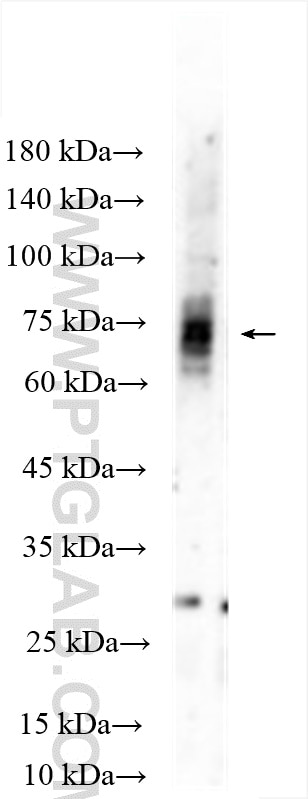- Featured Product
- KD/KO Validated
DRD1 Polyklonaler Antikörper
DRD1 Polyklonal Antikörper für WB, IF-Fro, ELISA
Wirt / Isotyp
Kaninchen / IgG
Getestete Reaktivität
human, Maus, Ratte
Anwendung
WB, IF-Fro, ELISA
Konjugation
Unkonjugiert
Kat-Nr. : 17934-1-AP
Synonyme
Geprüfte Anwendungen
| Erfolgreiche Detektion in WB | bei 37°C inkubiertes Maushirngewebe |
| Erfolgreiche Detektion in IF-Fro | Maushirngewebe |
Empfohlene Verdünnung
| Anwendung | Verdünnung |
|---|---|
| Western Blot (WB) | WB : 1:500-1:2000 |
| Immunfluoreszenz (IF)-FRO | IF-FRO : 1:200-1:800 |
| It is recommended that this reagent should be titrated in each testing system to obtain optimal results. | |
| Sample-dependent, check data in validation data gallery | |
Veröffentlichte Anwendungen
| KD/KO | See 1 publications below |
| WB | See 15 publications below |
| IF | See 6 publications below |
Produktinformation
17934-1-AP bindet in WB, IF-Fro, ELISA DRD1 und zeigt Reaktivität mit human, Maus, Ratten
| Getestete Reaktivität | human, Maus, Ratte |
| In Publikationen genannte Reaktivität | human, Maus, Ratte |
| Wirt / Isotyp | Kaninchen / IgG |
| Klonalität | Polyklonal |
| Typ | Antikörper |
| Immunogen | DRD1 fusion protein Ag12366 |
| Vollständiger Name | dopamine receptor D1 |
| Berechnetes Molekulargewicht | 446 aa, 49 kDa |
| Beobachtetes Molekulargewicht | 50-75 kDa |
| GenBank-Zugangsnummer | BC074978 |
| Gene symbol | DRD1 |
| Gene ID (NCBI) | 1812 |
| Konjugation | Unkonjugiert |
| Form | Liquid |
| Reinigungsmethode | Antigen-Affinitätsreinigung |
| Lagerungspuffer | PBS with 0.02% sodium azide and 50% glycerol |
| Lagerungsbedingungen | Bei -20°C lagern. Nach dem Versand ein Jahr lang stabil Aliquotieren ist bei -20oC Lagerung nicht notwendig. 20ul Größen enthalten 0,1% BSA. |
Hintergrundinformationen
Dopamine is a neurotransmitter that plays a crucial role in physical and mental health, such as cardiovascular, hormonal, renal, and central nervous systems (PMID: 29220802). Five subtypes of mammalian dopamine receptors are grouped into two classes, the D1- and D2-like classes. The D1-like class includes D1 and D5 receptors whereas the D2-like class includes D2, D3, D4 subtypes (PMID: 9457173). Dopamine receptor D1 (DRD1) is the most abundant form of dopamine receptor in the central nervous system. DRD1 stimulates adenylate cyclase, modulates D2 receptor activity, regulates neuron growth and differentiation, and mediates several behavioral responses (PMID: 1977312). DRD1 has a calculated molecular weight of 49 kDa, larger apparent molecular weight of 60-80 kDa may be due to glycosylation (PMID: 1281547; 23821371).
Protokolle
| PRODUKTSPEZIFISCHE PROTOKOLLE | |
|---|---|
| WB protocol for DRD1 antibody 17934-1-AP | Protokoll herunterladen |
| IF protocol for DRD1 antibody 17934-1-AP | Protokoll herunterladen |
| STANDARD-PROTOKOLLE | |
|---|---|
| Klicken Sie hier, um unsere Standardprotokolle anzuzeigen |
Publikationen
| Species | Application | Title |
|---|---|---|
Nat Commun Non-canonical interplay between glutamatergic NMDA and dopamine receptors shapes synaptogenesis | ||
EMBO Mol Med MicroRNA expression profile and functional analysis reveal that miR-382 is a critical novel gene of alcohol addiction. | ||
Elife The organic cation transporter 2 regulates dopamine D1 receptor signaling at the Golgi apparatus. | ||
J Affect Disord Pramipexole improves depression-like behavior in diabetes mellitus with depression rats by inhibiting NLRP3 inflammasome-mediated neuroinflammation and preventing impaired neuroplasticity | ||
Int J Mol Sci Effects of Maternal High-Fructose Diet on Long Non-Coding RNAs and Anxiety-like Behaviors in Offspring |



